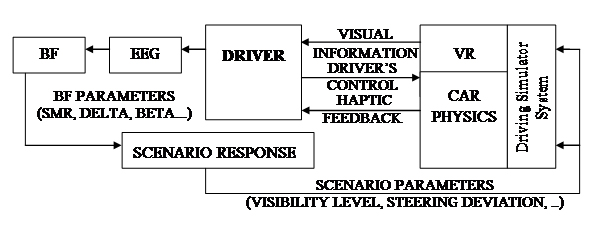Categories
Sub-categories
Technologies and systems development
EEG Biofeedback
A basic principle of biofeedback lays in use of direct interaction between suitable selected physiological regulatory signals of the human subject and the therapeutic system. The EEG based biofeedback belongs to the most popular and effective ones. With use of specially designed software it is possible to extract those signals and feed them back to the human subject in the way he/she can perceive it. The subject then tries to train himself to produce them intentionally and votive. Electrical brain waves from the subject’s skull are amplified, a frequency analysis is done and the significant parts of the spectra are on-line evaluated.
Measurements show that most effective for tasks coupled with attentiveness is stimulation in area around electrode C3 (in the system 10/20), while subject’s effort is to maximize SMR and suppress variance and aggression (theta and beta activity respectively). The therapeutic tools allow setting up different biases for SMR activation, which gives the possibility of progressive training. Next two graphs show analysis of the SMR, beta and beta2 activity of one subject in the beginning and by the end of the biofeedback training. It is possible to see that SMR activity is higher (testify for higher concentration abilities) meanwhile beta activity is relatively lower.

Shadow-Light projection system (DYICOLIS)
Scenarios with complex lighting - like road tunnels require more complex approach. The night driving scenarios (for measurements of driver’s fatigue, where the light changes could either influence the driver’s vigilance in positive sense or they can contribute to his/her discomfort) also provide the driver with much more complex light stimuli than common simulators can offer. Proceeding from those proposals in our laboratory we designed the so-called “Dynamic In-Cockpit Lighting System“.
The system idea was first introduced as DYICOLIS in 2007 providing basic functions. The DYICOLIS brought also several enhancements into the field of visual cuing. It can for example help the driver perceive the speed of the car (mainly in slower ranges) more accurately; it can partially solve the problem of inadequate optic flow, because it projects the picture directly in front of him/her. The couple of pictures below shows the simulator without (left) and with (right) incorporation of the DYICOLIS. We can see that the simulator equipped with inner lights and shadows, which are dynamically projected on its cockpit parts, immerses (or “plunge”) the subject deeply into the virtual scenery.
Visual information is considered to be of the biggest importance for driving. From such information the driver can easily derive information on his self-movement - speed, position, etc., but also about road or weather conditions for instance. Shadows cast by various objects appearing on the scene and lights coming from various sources (besides changeable light conditions) are just in “touching distance” to the driver and because of that fact they really intensively influence driver’s senses.

The DSRG design: 2011